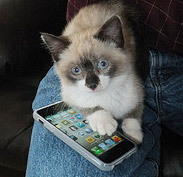Thieves Just Love Plucking Our Apple Products

(bikeoid)
For the last few weeks, every media outlet has been yapping about the proposed (then confirmed) new fingerprint-reading feature of the iPhone 5S. While it’s technologically interesting, the sensor could have an important impact on consumers’ lives and even on the crime rate in major cities. That’s because it could make snatching Apple products from consumers a lot less lucrative.
The iPhone was the first sleek smartphone with a shiny screen to become popular, and it has the international appeal and brand recognition that’s always important in the phone resale market. There are about 4,000 phones stolen in the United States every day. Smartphone mania is even blamed for messing with crime statistics in New York City in recent years. They’re small, they’re everywhere, and they’re easy to flip.
One reporter for public radio’s WNYC borrowed a co-worker’s phone, wiped the data, and found buyers quickly just driving around Brooklyn. The phone’s provenance? Not an issue.
Yes, governments and carriers could set up device blacklists and not allow stolen phones to be reactivated, but it’s awfully easy to just send a stolen phone to a different country. It can be more lucrative, too: some Hong Kong buyers used to offer as much as $2,000 for an iPhone.
The thumbprint reader might be Apple’s biggest effort toward deterring theft since the launch of “Find my iPhone,” but will it affect the traffic in stolen phones? Maybe all it will do is help keep the black-market resale value of older models high. Will thieves and illicit iPhone marketers find a way around Apple’s new protective measures? Will phone-snatching become less common as more secure devices hit the market? Guess we’ll find out soon. In the meantime, keep a tight grip on your smartphone.
Dear Apple: Good Luck Against The Smartphone Black Market [NPR]
Want more consumer news? Visit our parent organization, Consumer Reports, for the latest on scams, recalls, and other consumer issues.

